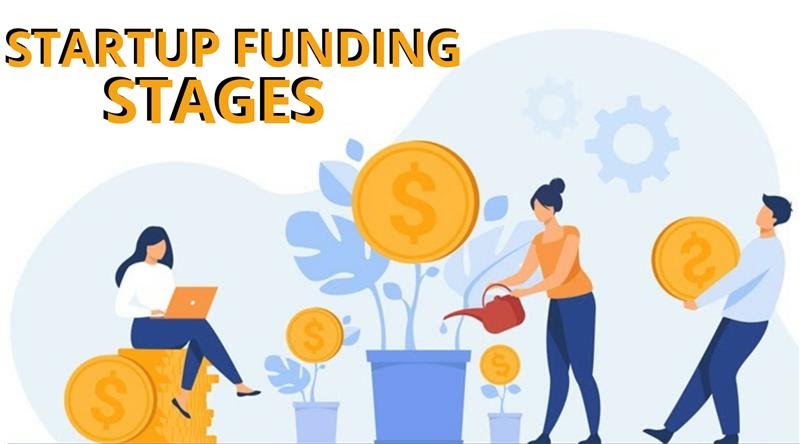A startup demands far more than simply an excellent idea. It goes through different startup funding stages.
So, if you’re successful, you walk off with money that will help your startup grow and become everything you hope it could become.
According to Wil Schroter who is the founder and CEO of Startups.com, “There’s not a lot of ‘fun’ in funding.”
So, your startup will need funding to grow. However, startup funding has a lot of stages. Let’s discuss ins and outs of each funding stage, here’s an overview of major startup funding stages.
Startup Stages of Funding You Must Be Aware Of
-
Pre-Seed Funding For Startup (The Bootstrapping Stage) –
This level is known as bootstrapping. It is when entrepreneurs build their businesses from scratch, without investors; it is just you, your idea, your savings, and your luck.
Strategies to be accomplished
- Market Testing
- Exploring the feasibility of building an idea into product/service
- Developing marketing and sales plan for the product launch
Potential Investors of Pre-Seed Stage
The most common pre-seed investors are:
- Startup Owners
- Friends and Family
- Early Stage Venture Funds (Micro VCs)
Startup Valuation in Pre-Seed Stage
Startups value anywhere between $10,000 to $100,000.
Fundraising
Startups able to raise approximately up to $50K
“The biggest factor in our decision-making is always the founding team, that’s what success lives or dies on in this industry: the ability for founders to make really quick, good decisions.”
-
Seed Funding or Angel Investor Funding (Product Development Stage)-
This stage is where the primary official funding starts. Funding from this stage may come from angel investors, crowdfunding, accelerators, and incubators.
Strategies to be accomplished
- Launch Product
- Build traction until revenue starts to come in
- Recruiting
- Development of a product for the market
Potential Investors of Seed Funding Stage
The common types of investors who participate in seed funding are:
- Friends and Family
- Angel Investors
- Early Stage Venture Funds (Micro VCs)
- Crowdfunding
Startup Valuation in Seed Stage
Startups value anywhere between $3M to $6M
Fundraising
Startups are able to raise approximately up to $3M
-
Series A Funding (First Round of Funding) –
After you’ve successfully developed, profited, and marketed from your seed round, then you’re ready for series A funding. Benefactors from this stage are angel investors and venture capitalists.
Strategies to be accomplished
- Working on the business model
- Placing the key team
- Scalable market blueprint
- Further development of a product/service.
Potential Investors of Series A Funding Stage
The common types of investors who participate in series A funding are:
- Accelerators
- Super Angel Investors
- Venture Capitalists
Startup Valuation in Series A Stage
Startups value anywhere between $10 million to $30 million
Fundraising
Startups are able to raise approximately up to $15 million
-
Series B Funding (Second Round of Funding) –
When your company generates a consistent revenue but must scale up to meet the growing customer demand, then you are ready for Series B funding.
If series A focuses on the development stage, series B concentrates on building and expanding market reach.
However, you will need a star investor who has more connections and an excellent track record to attract more investors.
Strategies to be accomplished
- Scaling up
- Increase market share
- Building high-quality teams
- Outlive competitors
Potential Investors of Series B Funding Stage
The common types of investors who participate in series B funding are:
- Venture Capitalists
- Late-stage VCs
Startup Valuation in Series B Stage
Startups value anywhere between $30 million to $60 million
Fundraising
Startups are able to raise approximately up to $30 million
-
Series C Funding (Third Round of Funding) –
If you’re trying to venture to series C funding, then you’ve got quite a successful company here. However, there’ll be some who want to travel further to series D funding.
Strategies to be accomplished
- Expansion
- Increase market share from home country to the international market
- Put the company on IPO track
Potential Investors of Series C Funding Stage
The common types of investors who participate in series C funding are:
- Late-stage VCs
- Private Equity Firms
- Hedge Funds
- Banks
Startup Valuation in Series C Stage
Startups value anywhere between $100 million to $120 million
Fundraising
Startups are able to raise approximately up to $50 million
-
Series D Funding (Special Funding Round) –
Many companies finish raising money with their Series C. However, there are a few reasons a company may choose to raise a Series D.
Companies are raising Series D rounds (or even beyond) to increase their value before going public. For instance, a merger and also if it has not yet hit its growth goal.
Strategies to be accomplished
- Merger with a competitor
- Get more funds to keep afloat
- Put the company on IPO track
Potential Investors of Series D Funding Stage
The common types of investors who participate in series D funding are:
- Late-stage VCs
- Private Equity Firms
- Hedge Funds
- Banks
Startup Valuation in Series D Stage
Startups value anywhere between $150 million to $300 million
Fundraising
Startups are able to raise approximately up to $100 million
-
Series E Funding
If a small portion of companies makes it to Series D, then only fewer make it to a Series E.
Companies that reach this point may be raised for many of the reasons listed in the Series D round: They’ve failed to meet expectations; they want to stay private longer, or they need a little more help before going public.
-
Mezzanine Financing (Bridge Loans)-
Mezzanine financing (also known as bridge loans) is a startup funding stage that’s all about preparing the startup for that final push to an exit. It’s a hybrid of loan financing and equity financing.
Mezzanine investors don’t require any hard collateral, but they do often ask for higher interest — usually between 12 to 20 percent than a traditional bank loan. They also ask for the right to convert their equity. This is if you default on the loan.
Because of the upper rate of interest, mezzanine financing is often riskier than other sorts of startup funding.
-
IPO (Stock Market Launch) –
IPO is the process of offering corporate shares to the general public for the first time. With an IPO, investment bankers commit to selling a certain amount of shares for a certain amount of money, thereby raising money for the company.
The shares are traded on the stock exchange. IPOs are seen as risky investments, as there’s no data yet on how the shares will trade.
Strategies to be accomplished
- Growth-oriented team
- Proper and stable financial statements
- Good Corporate governance
- Positive market sentiments
Potential Investors of IPO Stage
The common types of investors who participate in the IPO are:
- General Public
Startup Valuation in IPO Stage
Startups value anywhere around $100 million
Fundraising
Startups able to raise approximately $50 million to $500 million
In Conclusion
Sameer Dholakia, Former SendGrid CEO has said, “I think the biggest benefit is our increased brand visibility, which helps attract both new customers and teammates.”
Knowing your startup stage allows you to evaluate how your business is fairing; it determines if your business is scaling or remaining stagnant. This scale also allows you to choose what business plan you should use to grow your business more.
Do remember that to gain funding, startups must be mature enough to qualify for a specific funding round. You’ll identify where your startup stands by its net worth.
Also, Take a look at Alcor’s Venture Capital Pre Screening Assessment. Get your business assessed on our high-end AI platform to get a solution on how to get consulting clients fast with maximum results and funding from our global investors.









